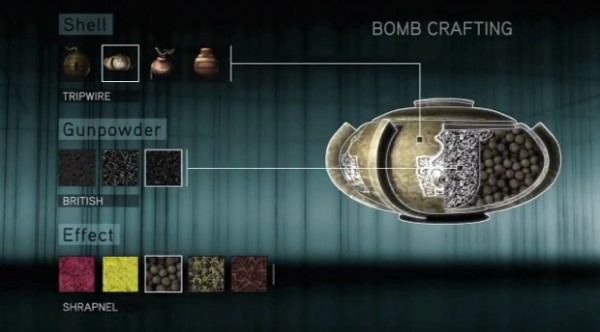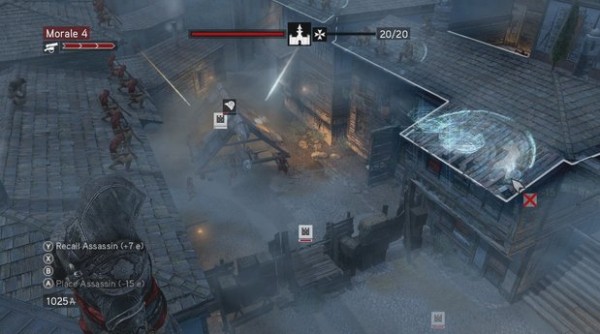Assassin’s Creed: Revelations is a follow-up to 2010’s Assassin’s Creed: Brotherhood, itself a follow-up to Assassin’s Creed II, and marks the end of Ezio Auditore da Firenze’s trilogy-within-a-trilogy. Does it stay true to the Creed or has age taken its toll on Ezio?
Warning: This article contains spoilers for previous Assassin’s Creed games.
The basic premise of Revelations remains unchanged from the earlier games: Desmond uses the Animus to relive the memories of his ancestors in order to help the modern-day Assassins in their fight against the Templars. Due to events at the end of Brotherhood, Revelations begins with Desmond trapped in the Animus within some kind of safety program to prevent his mind from tearing itself apart. To repair the damage, he must relive more of Ezio’s memories. Cue return to the Renaissance, where Ezio must stop the Templars’ nefarious plots and relive a few of Altair’s memories in the process.

Once back in the Renaissance, fans of the series will immediately recognize the game they’ve been playing for the last two installments; the flow of the combat and the design of the missions and city, Constantinople this time, are lifted directly out of Brotherhood. I won’t bother going over that here because either you’ve already played the earlier games in the series and know whether you like it, or you haven’t, in which case you can stop reading now. For those not yet invested in the series, Revelations is not the game to start with; if you’re interested in following the story then I recommend going back to the beginning, if not you can start with Assassin’s Creed II or Brotherhood. But whatever you do, Revelations should not be the first Assassin’s Creed game you play.
For those who have played the earlier games I will say this: Revelations is more of the same, but less of it. The minute-to-minute gameplay is identical to Brotherhood, with the addition of a bomb-crafting system which is entirely optional and can be exploited or ignored to suit player preference. Constantinople is like a rearranged and re-skinned Rome; the layout is different but you’ll definitely recognize its flow, the relationships between buildings and the way they seem to be studded just right with windows and ledges. You still burn towers to conquer districts, which allows you to renovate the structures within. The mission structure still has you going to a predetermined point on the map which activates a “memory” that you must complete to advance the story. I say it’s more of the same because nothing here is radically different, and very little is even slightly so.
I say it’s less of it because not everything made the voyage with Ezio from Rome to Constantinople. Gone are the side missions that had you helping the thieves, fighters and courtesans (Romanies now, which seems more than a little racist…). I don’t mean that there are fewer of them, I mean they are gone. Not in the game. There is one mission for each faction that unlocks that faction’s scattered groups for hire, and once that mission is completed there are no more. Those three missions, one for each faction, constitute the only side-quests in the entire game, a disappointment after the plethora of side-quests available in Brotherhood. There are only four lairs in the style of the Lairs of Romulus (five if you count the “bonus” one that came with certain editions) as compared to the six in Brotherhood. There is no modern day, outside-the-Animus section at all. In short, the missions have been pared down to just the main story and nothing else; sit still class, face forward.
Now that I’ve covered what’s the same and what’s gone, let’s talk about what’s been added.

Bombs. Ezio now has at his disposal a system for crafting and using bombs of various sorts: lethal, tactical, and diversion. You can probably guess what lethal bombs do. Tactical bombs are used to give Ezio some kind of advantage without directly doing damage, such as smoke bombs to conceal his actions or bombs that spread spikes on the ground to slow guards. Diversion bombs lure guards away from their posts, allowing the player to sneak by undetected. Bomb materials are found throughout the game world and can be purchased at black market vendors, and are crafted into bombs at stations scattered around the city. The crafting system is very deep; by combining three components: casing, gunpowder, and effect, Ezio can make hundreds of different bombs in each category, each slightly different than all the others. Using the bombs can be entertaining; I got a thrill out of dropping a smoke bomb in order to steal from a vendor without him ever knowing I’d been there, or drawing my target toward a haystack with a noise bomb so I could assassinate him from cover; the uses to which the player could put the bombs are endless. Here’s the thing though: you could also go through the entire game and never once use a bomb in anything other than the tutorial. The dynamics and design of the game are so similar to the previous games, which didn’t have and thus didn’t require bombs, that there is never a situation in which you need to use them. The bomb system comes across as little more than a gimmick tacked on to the existing play dynamic, rather than integrated into it.
The tower defense system has a similar feel to it. In Brotherhood, the player could attack Templar towers to liberate sections of the city, reducing guard presence in the area and unlocking shops for renovation. That system returns in Revelations, but now if your Awareness meter (known as Notoriety in Brotherhood) fills, the Templars might attack one of the towers in an attempt to retake it. If that happens then you must run to the area where you will play a game of tower defense in order to retain the district. Overall, it is decent; I’ve played both worse and better, but it’s so unnecessary for two reasons: the first is that if I wanted to play tower defense I would go play tower defense, right now I want to be playing Assassin’s Creed, but that criticism could really be levelled at almost any mini-game; the second reason is that it’s so easy to prevent the attacks that you never end up actually defending your towers. In all my time with the game I played the tower defense once, during its tutorial. After that I simply didn’t let my Awareness level get high enough; if it started to fill I would just bribe criers and kill witnesses until it went back down. To make my task even easier, the game allows you to install den masters in each tower you control, preventing their tower from being attacked. Once I had Master Assassin’s in all my dens I could let my Awareness meter fill up as much as I wanted and I never had to worry about losing a district, taking all the import out of a mechanic that might otherwise have added some interesting depth to the city control system.

The strangest addition to Revelations is probably Desmond’s Journey. Collecting artifacts within the Ezio segments of the game unlocks a series of first-person levels for Desmond to venture through in his part of the Animus, each one dealing with a portion of his own history. The gameplay of these sections has the player placing one of two kinds of blocks in order to traverse abstract rooms while hearing snippets of conversation from Desmond’s past. These puzzles are interesting enough, though somewhat simple; essentially they are just something to occupy the player while listening to bits of backstory. For players interested in Desmond and the larger story the explanation is nice, but the segments are ultimately forgettable.
There was at least one change for the better: the Assassin recruitment and training system, introduced in Brotherhood, is much deeper this time around. Destroying Templar towers still unlocks recruitment slots and your trainee Assassins level up via missions you send them on but now, once at level 10, they can be promoted to the leader of a den, and once at level 15 they become Master Assassins and keep their den safe from the Templars. Also, at the start of the game, each city around the Mediterranean is controlled by the Templars but can be taken for the Assassins by sending your recruits to perform missions there. You can install Assassins in captured cities (freeing up their slot for a new recruit), and each captured city gives benefits such as a certain amount of gold per day and experience for any Assassins stationed there. The Templars will attempt to retake cities, so you must maintain your control by performing missions. The system plays out as a continental version of the city districts, but is much more engaging in the long term. I spent more time than I probably should have just managing my recruits and conquering cities, and had quite a bit of fun doing it.
In sum, while a lot of the changes were unnecessary, and some were for the worse, the core of the game is still Assassin’s Creed and is still a blast to play. The series has suffered from its yearly release schedule, and Revelations is a definite step down from Brotherhood, but at its core it’s still the same game. If you’re expecting a game that breaks new ground for the series you will be disappointed, but if all you want is more Assassin’s Creed then Revelations delivers. In terms of length the main story is comparable to the previous entries, but the lack of side content means ultimately you’ll probably spend less time in Constantinople than you did in Rome. Ezio may be showing his age, and may not have the energy to do everything he once did, but the things he still does he does just as well as ever.
Developer: Ubisoft Montreal
Genre: Action-Adventure
Price: $60/£36/€70 Xbox 360/PS3, $50/£30/€50 PC
Time: 10-25 hours, depending on completion.
Gripes: Lack of side-missions, new content adds little to the experience, shorter than previous entries.
Get it for the: Assassin’s Creed gameplay you know and love.
Full disclosure: I purchased, played, and reviewed the PC version.

